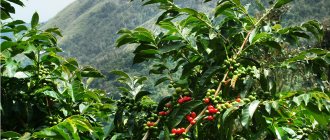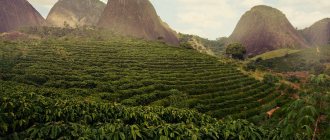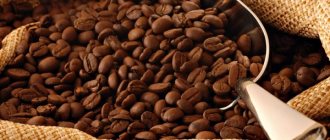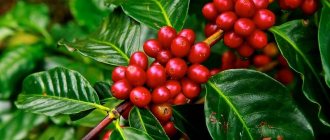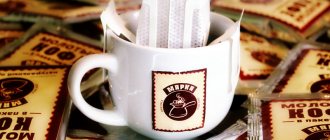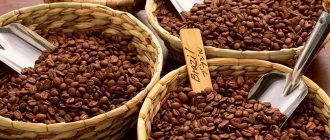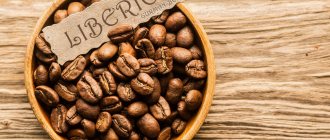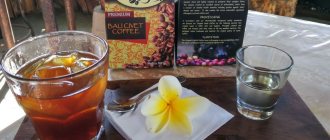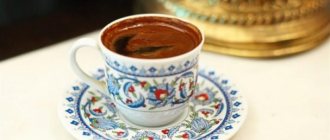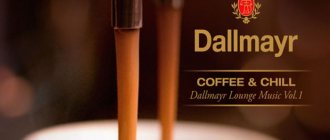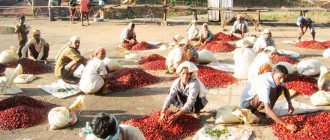Many of us drink one, and some several, cups of coffee a day. This drink energizes you, and sometimes helps you relax and step away from the bustle of the big city. The different effect of the drink depends on what type of coffee tree the drink is made from. If we want to get a charge of vivacity and strength, then the choice should be made in favor of robusta. Let's take a closer look at it.
History of origin of the variety
Robusta is native to Africa. At the beginning of the 18th century, it was found in the central part of the African continent, near the banks of the deepest river in Africa - the Congo. The place where she was found gave her another name. It is often called “Congolese coffee”.
It was only in the 20th century that coffea canephora gained its popularity. This was caused by a disease called leaf rust. It destroyed a large number of Arabica coffee plantations, which had been known throughout the world for several hundred years. As a result, coffee producers turned their attention to robusta, which turned out to be more productive and practically not susceptible to diseases and insect attacks.
History of the Venturim family
Amadeo Venturim began growing Arabica beans in southern Brazil in 1882, immediately after immigrating from Italy. His sons continued his work. In the early 1900s, the family acquired cheaper land in the northern part of the state and also began growing coffee there in 1925. In the 1960s, after the global coffee crisis, Isaac's father cut down the Arabica trees and, like many of his neighbors, began to grow Robusta, which until then was an unknown variety in Brazil.
fazenda Venturim, source @cafefazendaventurim
In 2007, the family decided to produce specialty coffee and began to update their plantings and improve post-harvest processing methods. Since 2012, the farm has been depulping berries on its own. In 2020, Venturim experimented with fermentation for the first time, which opened the doors to the best roasters and coffee shops in the world.
“Robusta berries are much sweeter than Arabica and have a pleasant taste. If Arabica is primarily reminiscent of sweet peas, then Robusta is the powerful sweetness of Turbo chewing gum (the effect is the same) ... "
— Hummingbird Coffee
Where does Robusta grow?
The equatorial areas of the lower slopes of Africa and Asia have become the best places in which Congolese coffee is currently grown. Ideal conditions for growth are:
- Altitude above sea level 200-900 meters;
- High air humidity;
- Air temperature from 10 to 30 degrees (at temperatures below +10 the tree may die).
On coffee plantations, the growth of the coffee tree is limited. To make it easier to harvest coffee fruits, the trees are pruned and formed into a small bush. During the flowering period, the tree is strewn with white and pink flowers, and the coffee plantations become a very picturesque place.
Where is coffee grown?
The taste, aroma and quality of the final product largely depend on the place of production.
Most of the countries where coffee plantations are located are located within the tropical zone. They make up the so-called “coffee belt”.
Central America Jamaica; Mexico; Panama; Nicaragua; Haiti; Belize; Honduras; Cuba; Dominican Republic; Guatemala; Costa Rica; Salvador; Puerto Rico.
In these countries, only Arabian coffee of different varieties is grown. Only Guatemala is simultaneously producing robusta, which is less demanding on growing conditions.
South America This continent accounts for half of the world's grain exports.
Brazil; Guyana; Venezuela; Bolivia; Colombia; Ecuador; Paraguay; Guiana; Peru; Colombia; Suriname; Trinidad and Tobago.
The vast majority of these countries are focused on the cultivation of Brazilian Arabica. The exceptions are Brazil and Ecuador, where Congolese coffee is also cultivated.
Asia India; Thailand; Indonesia; Yemen; China; Philippines; Vietnam; Malaysia; Myanmar; East Timor; New Guinea.
Arabica and Robusta are simultaneously cultivated in this region. Moreover, the latter is given clear preference. Indonesia holds the lead in Arabian coffee production, while Vietnam holds the top spot for Robusta coffee. In addition, in the Philippines they breed Liberica, which is used to create elite mixtures.
Africa Coffee production on this continent has a long history.
Angola; Ethiopia; Tanzania; Zambia; Ivory Coast; SOUTH AFRICA; Uganda; Madagascar; Zimbabwe; Angola; Botswana; Congo; Cameroon; Kenya; Saint Helena Island.
From this part of the world, not only 2 traditional types of coffee are supplied to different countries of the world, but also such rare varieties as Excelsa, Liberica and Cameroonian coffee.
Australia Coffee plantations appeared in this state only in the 70s of the last century. Since the arid climate was not very conducive to growing a moisture-loving crop, the Australians developed a special drought-resistant Arabica variety, Skybury.
The largest coffee producers in the world
Brazil has been the absolute leader among coffee exporters . The second largest coffee producer is Costa Rica . As in Brazil, Arabian coffee imported from Ethiopia is cultivated here.
Third place in the ranking belongs to Colombia . The drink, made from beans grown in this country, is considered one of the best in the world.
Vietnam holds fourth position among all producers of aromatic grains in the world . Every year he sells more than a million tons of robusta abroad.
A significant percentage of the grains that go into making famous brands are purchased in Indonesia . However, many coffee plantations in this state are cultivated by small farmers.
Mexico occupies not the last place among Arabica exporters . At the same time, a significant part of locally produced products is supplied to the United States.
The largest African supplier of Arabica beans is Ethiopia , the native land of this species. At the same time, half of the raw materials produced in the country are spent on domestic consumption.
In recent years, India . Thanks to its southern plantations, the country has become one of the leading sellers of robusta.
Composition and taste
Robusta production accounts for 30% of the world's coffee production. This is due to the fact that robusta coffee has a weak aroma, strong taste and some bitterness. This is explained by the composition of the coffee bean:
- 8% aromatic oils;
- 5% sugars;
- 3% caffeine.
The low content of aromatic oils and sugars does not allow the finished drink to obtain a richer taste and aroma. The high caffeine content makes it more energizing. This drink will please those people who adore strong, bitter coffee.
Specialty robusta
Until recently, the phrase “specialty robusta” sounded at least strange: everyone knew that there were only specialty arabica beans. But in 2010, a group of scientists from robusta-producing countries, under the auspices of the Coffee Quality Institute, developed a program for assessing the quality of robusta. Recommendations were issued on the cultivation, collection, processing and storage of grains, and educational programs were conducted for farmers.
Specialty Robusta ripens more evenly than regular Robusta
The international panel of judges of the Brazilian Cup of Excellence competition, who tasted Specialty Robusta from India and Ecuador, was surprised to note that instead of the usual shades of earth and burnt rubber, properly dried and processed grains tasted of bergamot, pineapple, coconut, honey, vanilla, macadamia, and gooseberry. The scientists involved in the project believe that the future lies in high-quality robusta.
How is robusta used and what does it add to coffee?
Separate use of coffea canephora is rare. A drink made from 100% Robusta is inferior in taste to coffee made from Arabica. The taste is specific - rough and bitter. The structure of the drink is watery.
For the best price-quality ratio, manufacturers usually make a mixture of Arabica and Robusta. The most common ratio is 80% Arabica and 20% Robusta. Their union turns out to be quite successful:
- The drink acquires a slight bitterness;
- The coffee becomes stronger (compared to 100% Arabica). This is most relevant for making espresso;
- The rich aroma that is present in Arabica beans remains;
- The final cost of the product is reduced (robusta is cheaper).
Coffee blends containing robusta can be found in instant coffee and drinks that we buy from vending machines. In these mixtures its content can be more than 50%. This is done to reduce the final price of the product.
When producing instant coffee, the specific bitterness of the drink is lost. There is a misconception that the lack of bitterness makes a coffee drink less invigorating. For many, the main goal of drinking coffee is to get a boost of vigor and energy for the whole day.
We hope that our article was useful. We introduced you to an interesting coffee variety that has its own advantages and disadvantages.
We recommend reading our articles about Arabica and the differences between Arabica and Robusta to make your final choice. Perhaps this information will help you become a coffee connoisseur in these topics.
Robusta (coffea canephora)
Robusta is a type of coffee tree - plants from the coffee genus of the Rubiaceae family. Coffee beans are named after him. The name “robusta” means “strong” because the tree can survive in conditions where other types of coffee trees, such as Arabica, cannot take root. The birthplace of Robusta coffee is Central Africa, the Congo River basin. Hence one of its names - “Congolese coffee”. At the beginning of the last century, robusta seedlings were delivered to the island of Java, where they quickly took root, and then robusta spread to southeast Asia and South America.
Robusta is an evergreen shrub or small tree, 2 to 10 m high, long-lived and vigorous, with vertical and horizontal branches that fall off after natural death. The bulk of the roots are concentrated in the surface layer of soil 15 cm deep. The flowers are white or pale pink, often with a creamy-brown star, fragrant, the leaves are large. The fruit is a round dark red berry up to 1.5 cm wide, smaller in size than Arabica, with a strong peel, under which there is a thin pulp. The seeds are surrounded by a gray-green parchment shell. The seeds are paired, greenish-gray, oval on one side, flat-convex with a deep groove on the other. They ripen in 10-11 months. Fruiting begins at the age of 2.5-3 years. One tree produces 1.5 kg of coffee beans.
Robusta grows at an altitude of 200-900 m. The ideal temperature environment is 20-30 degrees. This is an unpretentious and productive species of coffee trees. Its main feature is high stability. It can easily withstand temperature changes and high humidity, grows well in low-lying areas and even in valleys, where Arabica is simply unable to grow. Robusta is resistant to the scourge of Arabica - rust, a disease that at one time destroyed almost all Arabica plantings in Brazil within two years. The stability of the species is largely related to self-pollination, hence its resistance to external influences.
Due to the above factors, as well as the high yield percentage, the cost of this type of coffee is much cheaper, while Arabica is one of the most expensive coffee types. The price is also determined depending on the method of grain processing - dry or wet. Wet processing is always more expensive. Robusta is processed mainly using the dry method.
Robusta and Arabica are the main types of coffee in global production. The first accounts for 20-30%, the second - 70% of world coffee production. Currently, Robusta is grown in all tropical countries, like Arabica. However, there are countries where the cultivation of robusta is strictly prohibited to avoid interbreeding, such as in Colombia and Costa Rica.
Robusta and Arabica differ greatly in taste and chemical composition. Compared to Arabica, Robusta is considered a lower quality variety. The coffee turns out richer, stronger, with pronounced bitterness, with a less refined aroma and astringent taste.
Robusta contains only 8% essential oils, which makes the taste of the grain and drink quite simple, without the flavor nuances of Arabica. This low oil content also explains the weak aroma of Robusta. Sugar content - 4-5%. When roasting, the beans are colored unevenly, since it is the caramelizing sugary substances that give the dark color to the roasted coffee. A small proportion of sugar makes the drink taste sharp. Tannins and amino acids, including chlorogenic acid, contained in this species are responsible for bitterness and give Robusta an astringent, coarse and bitter taste. Robusta beans contain 3% caffeine, twice as much as Arabica. The strength of Robusta coffee is much higher, it tones and invigorates better and stimulates brain activity.
Robusta is often found in instant coffee and espresso blends. It is Robusta that gives espresso a persistent and thick crema, which is revered by lovers of coffee drinks. This happens because Robusta tannins make the grain structure denser and a dense, stable foam forms on the drink, while pure Arabica crema is watery, bubbly and very unstable. Robusta is processed dry, while Arabica beans are wet processed, which gives the drink a slight sourness, refined taste and aroma.
Robusta is rarely used in single varieties; it is most often added to mixtures for strength and deepening of taste. All espresso blends contain Robusta. Arabica and Robusta are often used in a mixture with each other; they complement each other perfectly. The classic ratio is 80% Arabica and 20% Robusta. Currently, the share of robusta is increasingly increasing, as this leads to a reduction in the cost of the product.
The best varieties of Robusta are Nanu, Java Ineac, and Conillon Brazil.
To produce high-quality coffee, only ripe fruits are harvested. For a cheap drink, use any, including unripe ones. The grains are removed from the fruits manually or using special machines. There are two ways to clean coffee beans - dry and wet.
During dry cleaning, the grains are poured onto areas in even layers and dried in the sun for three weeks. They are mixed and protected from night moisture. Then the grain is taken out of them and cleaned. Dry cleaning is naturally done during the dry season. This is how robusta is cleaned.
When wet peeling, the berries are placed in water for a day, after which they are cleared of pulp by machine. The grains with remaining pulp are washed. Large, healthy beans remain at the bottom of the containers, while low-quality and unripe beans float to the surface. This is how the grains are sorted at the first stage. Next, a fermentation process takes place, as a result of which the grain acquires a shiny, smooth appearance. Wet cleaning produces higher quality coffee. Wet cleaning can be done both during the dry season and during the rainy season, such as in India or Colombia. This is how Arabica beans are purified.
Next, the dry coffee is packed into bags and aged for a year, and some varieties for up to ten years. After aging for a long time, the coffee is roasted in different ways with different degrees of roasting - weak, medium, strong. Dozens of nuances can depend on the degree of roasting - color, aroma, acidity, richness, intensity, oil content and other characteristics.
Roasted and properly packaged coffee cannot spoil or cause harm, but it quickly loses its taste. Ideally, coffee can be called fresh only if no more than two months have passed since roasting and if it has been properly stored.
For the medicinal and cosmetic properties of coffee, see Arabica coffee.
